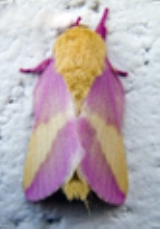
Dryocampa rubicunda
Encyclopedia
The Rosy Maple Moth is a North American moth
in the Saturniidae
family. Males have a wingspan of 32–44 mm; females of 40–50 mm. They have reddish-to-pink legs and antennae, yellow bodies and hindwings, and pink forewings with a triangular yellow band across the middle. Males have bushier antennae than females. As the name implies, rosy maple moths mainly feed on Maple
s, particularly Red Maple
, Silver Maple
, and Sugar Maple
. Sometimes these moths become pests on maple trees.
, but the final two are solitary. The mature larva
e are light green with black lateral lines, red heads, and two filaments behind the head, and reach lengths of about 55 mm. When they are ready, they climb to the bottom of the host
tree and pupa
te in shallow underground chambers. The pupae are very dark, elongated, and have small spines. The pupa ends in a small forked point. When the imago
(adult) eclose
s, it has small wings which it has to pump full of fluid in order for them to expand and allow for flight. Adult moths are generally nocturnal; they preferentially fly throughout the first third of the night (Fullard & Napoleone 2001). The females emit pheromone
s at night and attract males, which have bushier antennae to detect the pheromones.
Moth
A moth is an insect closely related to the butterfly, both being of the order Lepidoptera. Moths form the majority of this order; there are thought to be 150,000 to 250,000 different species of moth , with thousands of species yet to be described...
in the Saturniidae
Saturniidae
The Saturniidae, commonly known as saturniids, are among the largest and most spectacular of the moths. They form a family of Lepidoptera, with an estimated 1,300 to 1,500 described species worldwide...
family. Males have a wingspan of 32–44 mm; females of 40–50 mm. They have reddish-to-pink legs and antennae, yellow bodies and hindwings, and pink forewings with a triangular yellow band across the middle. Males have bushier antennae than females. As the name implies, rosy maple moths mainly feed on Maple
Maple
Acer is a genus of trees or shrubs commonly known as maple.Maples are variously classified in a family of their own, the Aceraceae, or together with the Hippocastanaceae included in the family Sapindaceae. Modern classifications, including the Angiosperm Phylogeny Group system, favour inclusion in...
s, particularly Red Maple
Red Maple
Acer rubrum , is one of the most common and widespread deciduous trees of eastern North America. It ranges from the Lake of the Woods on the border between Ontario and Minnesota, east to Newfoundland, south to near Miami, Florida, and southwest to east Texas...
, Silver Maple
Silver Maple
The silver maple —also called creek maple, river maple, silverleaf maple, soft maple, water maple, or white maple—is a species of maple native to eastern North America in the eastern United States and Canada...
, and Sugar Maple
Sugar Maple
Acer saccharum is a species of maple native to the hardwood forests of northeastern North America, from Nova Scotia west to southern Ontario, and south to Georgia and Texas...
. Sometimes these moths become pests on maple trees.
Life cycle
Females lay pale yellow eggs in clusters of 20-30 on the undersides of maple leaves. After about two weeks, small gregarious caterpillars hatch. They will remain gregarious through the third instarInstar
An instar is a developmental stage of arthropods, such as insects, between each molt , until sexual maturity is reached. Arthropods must shed the exoskeleton in order to grow or assume a new form. Differences between instars can often be seen in altered body proportions, colors, patterns, or...
, but the final two are solitary. The mature larva
Larva
A larva is a distinct juvenile form many animals undergo before metamorphosis into adults. Animals with indirect development such as insects, amphibians, or cnidarians typically have a larval phase of their life cycle...
e are light green with black lateral lines, red heads, and two filaments behind the head, and reach lengths of about 55 mm. When they are ready, they climb to the bottom of the host
Host (biology)
In biology, a host is an organism that harbors a parasite, or a mutual or commensal symbiont, typically providing nourishment and shelter. In botany, a host plant is one that supplies food resources and substrate for certain insects or other fauna...
tree and pupa
Pupa
A pupa is the life stage of some insects undergoing transformation. The pupal stage is found only in holometabolous insects, those that undergo a complete metamorphosis, going through four life stages; embryo, larva, pupa and imago...
te in shallow underground chambers. The pupae are very dark, elongated, and have small spines. The pupa ends in a small forked point. When the imago
Imago
In biology, the imago is the last stage of development of an insect, after the last ecdysis of an incomplete metamorphosis, or after emergence from the pupa where the metamorphosis is complete...
(adult) eclose
Eclose
Eclose is a commune in the Isère department in south-eastern France....
s, it has small wings which it has to pump full of fluid in order for them to expand and allow for flight. Adult moths are generally nocturnal; they preferentially fly throughout the first third of the night (Fullard & Napoleone 2001). The females emit pheromone
Pheromone
A pheromone is a secreted or excreted chemical factor that triggers a social response in members of the same species. Pheromones are chemicals capable of acting outside the body of the secreting individual to impact the behavior of the receiving individual...
s at night and attract males, which have bushier antennae to detect the pheromones.

